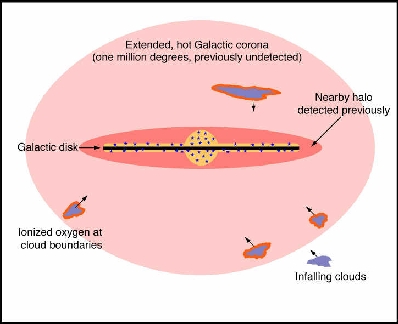
Presentation courtesy of William Blair, JHU.

Caption: The presence of patchy clouds of neutral hydrogen gas around the Milky Way have been known for years. FUSE has observed distant objects behind many of these clouds. The cloud imposes a spectral signature on the spectrum of the distant object, from which FUSE astronomers can learn about the cloud composition and velocity. (Click figure to see larger JPEG version. Also, a simpler black and white version of this figure suitable for newspaper use is available by clicking HERE.)
One of the key scientific programs of the FUSE mission is to understand the abundance of deuterium in the Universe. Deuterium is an isotope of hydrogen whose atoms contain a proton and a neutron instead of just a proton. A curious fact of the Universe is that deuterium was manufactured almost exclusively in the Big Bang, and should have only decreased in abundance with time as deuterium is destroyed in stars. (See a separate write-up for further details.) But measuring deuterium in the Universe is a very difficult task, and it has been hard for scientists to confirm or refute this picture.
Over the last year or so, results and analysis of data from the WMAP satellite have been used to set new and relatively accurate values for many parameters in cosmology, including the so-called "primordial" (Big Bang) abundance of deuterium. This value is about 27 parts per million of deuterium relative to regular hydrogen. For comparison, the accepted value for the deuterium abundance in the gas near the solar system is only 15.2 parts per million.
In a recently published article, Kenneth Sembach of STScI and co-workers have now made a unique observation with FUSE that measures the deuterium abundance in gas that has had only relatively modest processing through stars. Using a distant quasar (known by its catalog name of PG1259+593) as a background source, Sembach et al. have measured the deuterium abundance in an intervening gas cloud in the halo of the Milky Way. The gas cloud, known as "complex C", is called a high-velocity cloud because we observe the cloud moving toward us at some 120 km/s; since it is seen in the halo of our Galaxy, it is a cloud of gas that is caught in the act of falling into the Milky Way. Because the spectral signatures of deuterium and hydrogen are closely spaced in FUSE spectra, this "blueshift" of the deuterium features is helpful in making a good measurement.

Caption: This figure shows a tiny part of the FUSE spectrum of a distant quasar. The light from the quasar is used as a background source, and "dips" in the spectrum are caused by absorption of this background light by intervening gas. Since wavelength of light is related to velocity (through the Doppler formula), we show a wavelength scale on the top (in nanometers) and a velocity scale on the bottom (in kilometers per second). Deuterium is seen at the velocity of a "high velocity cloud" that is falling into our Galaxy. (Note: 200 km/sec = 720,000 km per hour, or almost half a million miles per hour if you prefer!) (Click figure to see larger JPEG version.)
The FUSE data also include many fingerprints of oxygen and other elements. Careful analysis of these data shows that the complex C gas cloud has average heavy element abundances that are only 1/6th those seen in the sun. This means the gas has had much less processing through previous generations of stars than the material that formed our solar system, and thus the complex C cloud would be predicted to have a higher abundance of deuterium.
Sure enough, Sembach et al. conclude that the deuterium abundance in complex C is about 22 parts per million, intermediate between the primordial and local values, and consistent with the general picture of deuterium destruction through stellar processing!
I titled this document saying this was a "unique" measurement. It takes quite a coincidence to find a background so urce behind a high velocity cloud that is bright enough to make such a measurement. PG1259+593 is the best source of this type known, and yet it took a total integration of nearly half a MILLION seconds with FUSE to obtain the data used for this measurement! We either need Nature to provide some brighter sources, or we need a bigger telescope to make additional measurements of this type!

Photo credits: Graphics courtesy Ken Sembach, STScI.
On-line version of the research article by K. R. Sembach et al. (2004, Astrophysical Journal Supplement, 150, 387).